Ismaïla Sarr joined Watford last summer from French side Stade Rennais.
He spent two seasons at the Ligue 1 club after starting his senior career at Metz just a year before.
European giant FC Barcelona even attempted to sign the Senegalese when they were still playing for Metz.
However, Sarr chose Rennes over FC Barcelona because of the club’s playing time guarantee, a decision that proved correct for his career development.
His choice was correct.
Sarr’s brilliant performance for Rennes helped him to secure a place in Senegal’s 23-man squad for the 2018 FIFA World Cup.
The fairytale doesn’t stop there.
Last year, Sarr helped Senegal to reach their second-ever African Cup final in the nation’s history.
That was enough to convince Watford to sign him last August.
Without further ado, this tactical analysis will inform you about his role and impact for the Hornets.
Ismaïla Sarr Style Of Play
Ismaïla Sarr is a versatile winger who can play on both flanks.
At Rennes, he played 20 games on the left flank, making three goals and six assists in two seasons.
However, his best position seems to be in the opposite wide area.
Looking at the stats, he spent 33 games for Rennes as a right-winger.
From those games, he’s managed to score eight times and assisted seven.
Sarr’s versatility doesn’t stop there.
The French club even played him as a centre-forward for a couple of times.
During his time at Rennes, the Senegalese played at least 18 matches as a target man across two seasons.
He even contributed seven goals when playing centrally.
A pretty respectable number, to say the least.
Moving to Watford, Sarr is moved permanently to the right flank.
The decision is understandable because the Hornets’ opposite wide area is flooded with more prominent names like Gerard Deulofeu and Roberto Pereyra.
So far, it’s safe to say that Sarr is comfortable playing as a right-winger week in and week out.
Per the statistics, the 22-year-old starts his Premier League career with five goals and four assists in just 1,226 minutes of playing time.
Such a feat proves Ismaïla Sarr’s style of play suits Watford’s tactics.
Ismaïla Sarr Attacking Position
This part of the scouting report will examine Ismaïla Sarr’s attacking position in the Hornets’ tactics.
Watford prefers to use a direct approach to build their attacks.
If we look at the statistics, the particular style suits their target man, Troy Deeney, very well.
So far, Deeney has managed to win 7.6 aerial duels per game; joint-highest in the league.
The long balls would be provided to the talisman before being laid off by one of his attacking comrades.
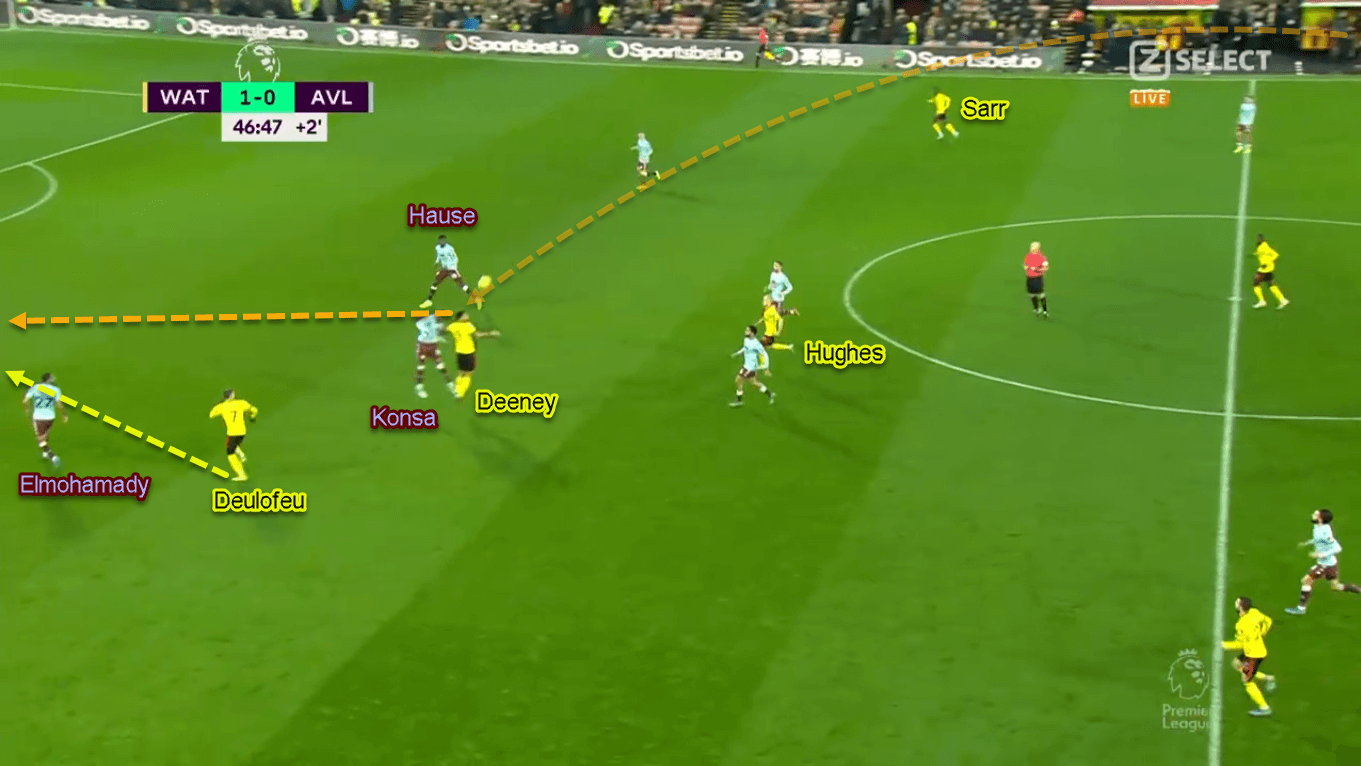
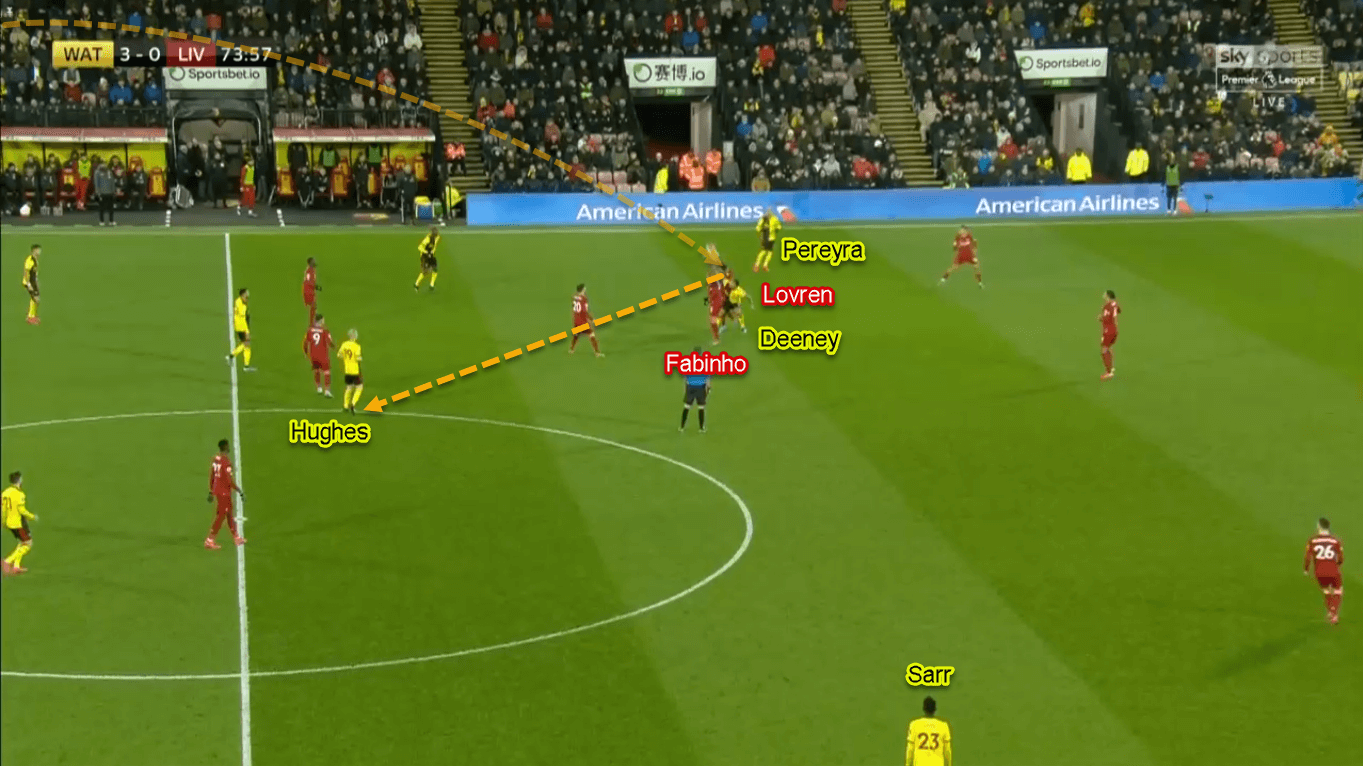
Mainly, Ismaïla Sarr doesn’t participate in the direct approach.
Ismaïla Sarr would stay wide, hugging the touchline, and provide the width for his team.
By doing so, he could stretch the opponents’ backline and allow (one of) the midfielders to come to nearby Deeney.
However, Ismaïla Sarr’s attacking position doesn’t make the Senegalese useless in Watford’s attacking scheme.
Instead, his broad positioning has a particular purpose.
Ismaïla Sarr can be used whenever Watford needs to switch the play.
The right-winger could then be served by a diagonal pass from one of his teammates from the deeper position, mainly by Étienne Capoue.
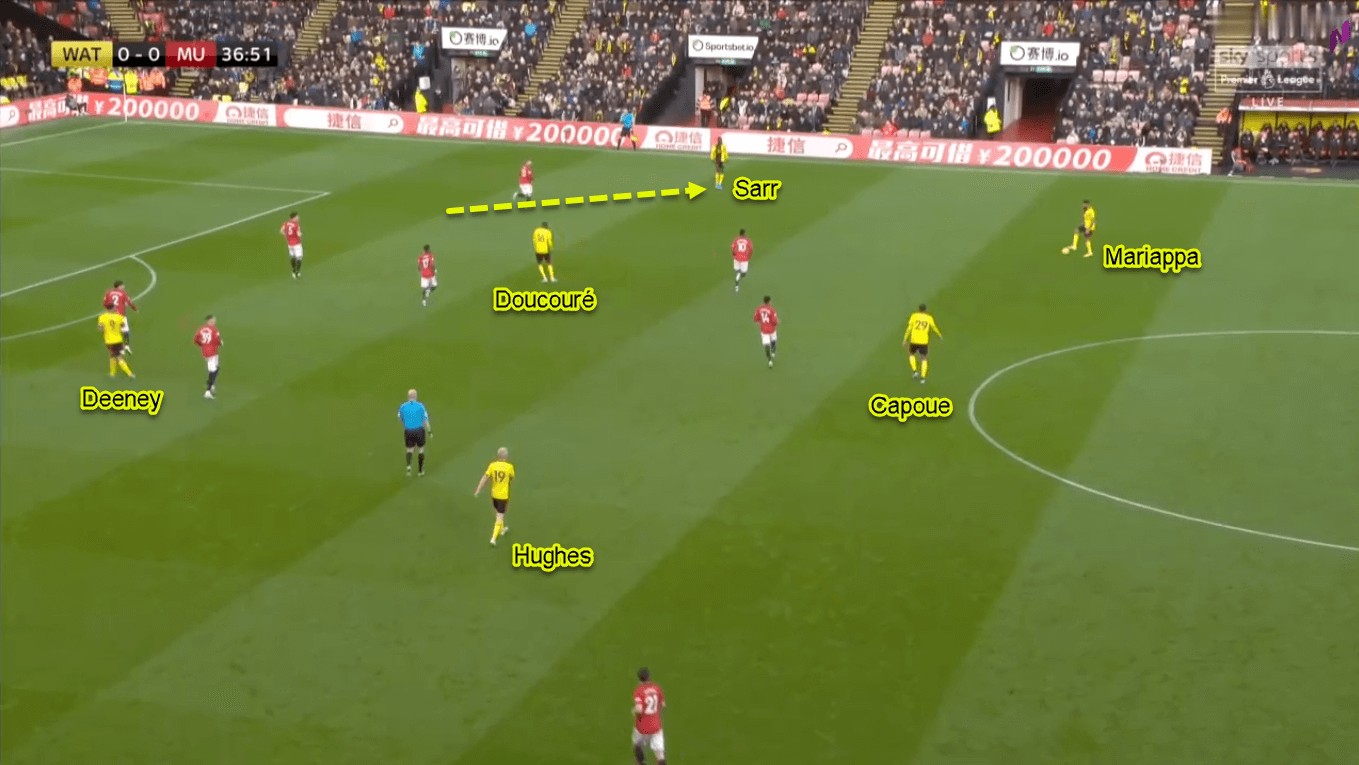
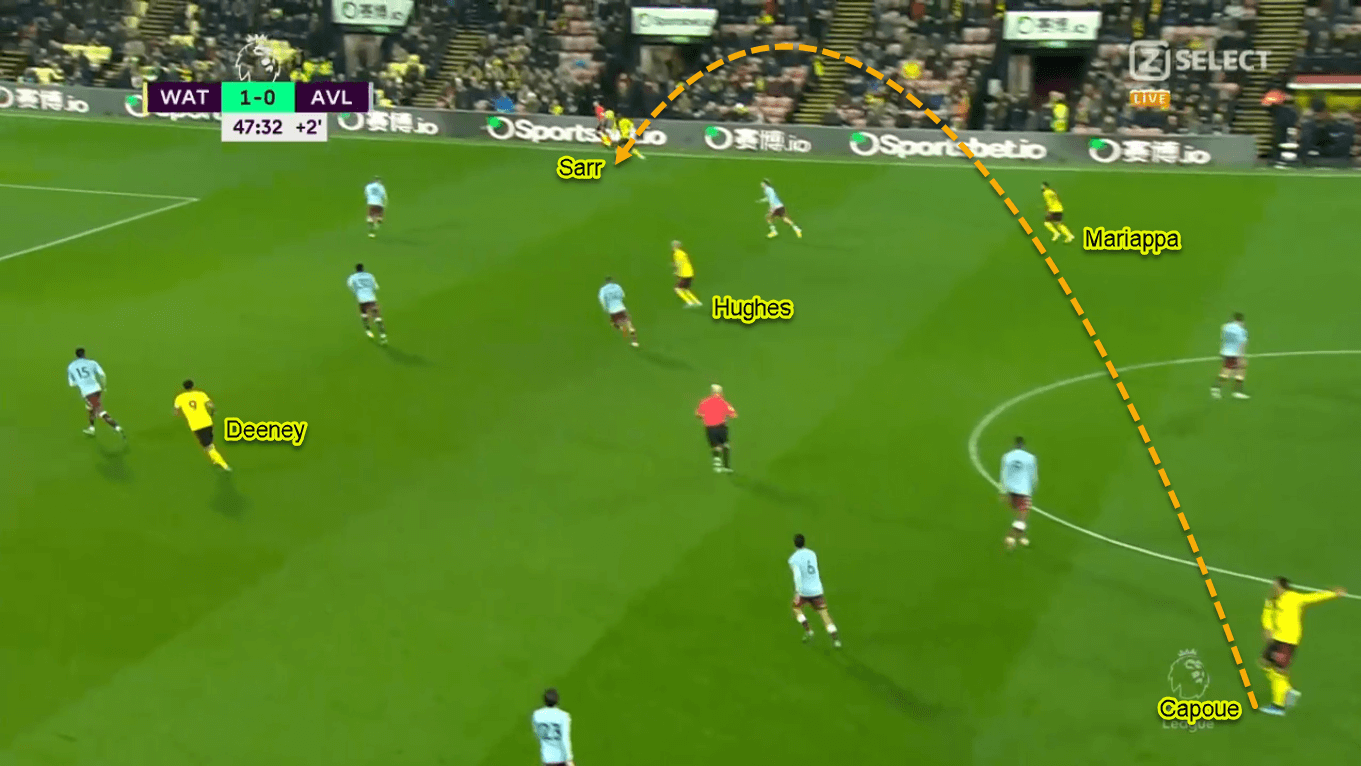
Ismaïla Sarr Style Of Play – Final Third
After receiving the ball in his playing area, Ismaïla Sarr would be tasked to play quite directly.
This means he would try to send crosses into the box for his attacking comrades.
Nigel Pearson would flood the penalty box with up to four players to win the cross.
In such situations, Targetman Deeney would be supported by Abdoulaye Doucouré, Deulofeu, and one of the central midfielders.
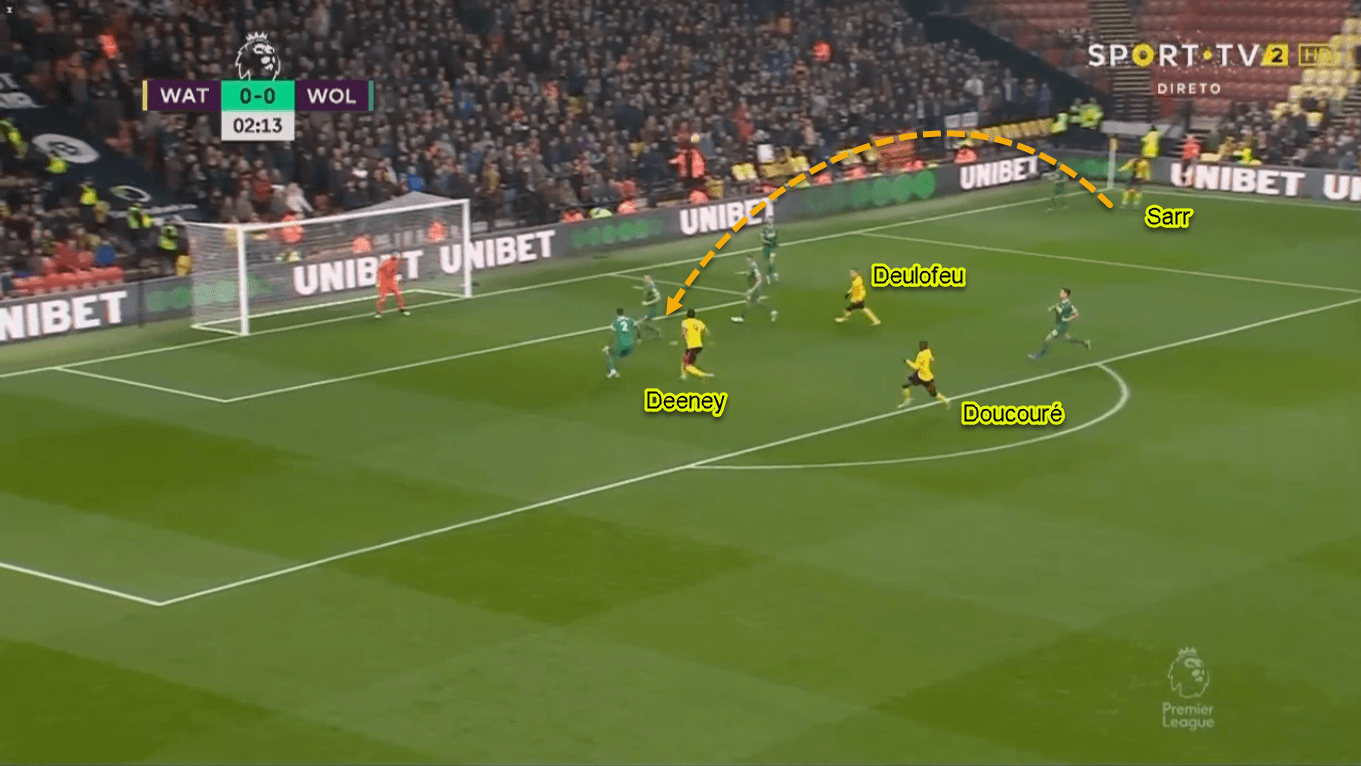
Similarly, Ismaïla Sarr would also help to flood the penalty box when the ball is being played from the opposite side.
The Senegalese’ relatively massive physique (185 centimetres and 76 kilograms) is quite similar to Watford’s front two, making him a threat in crossing situations.
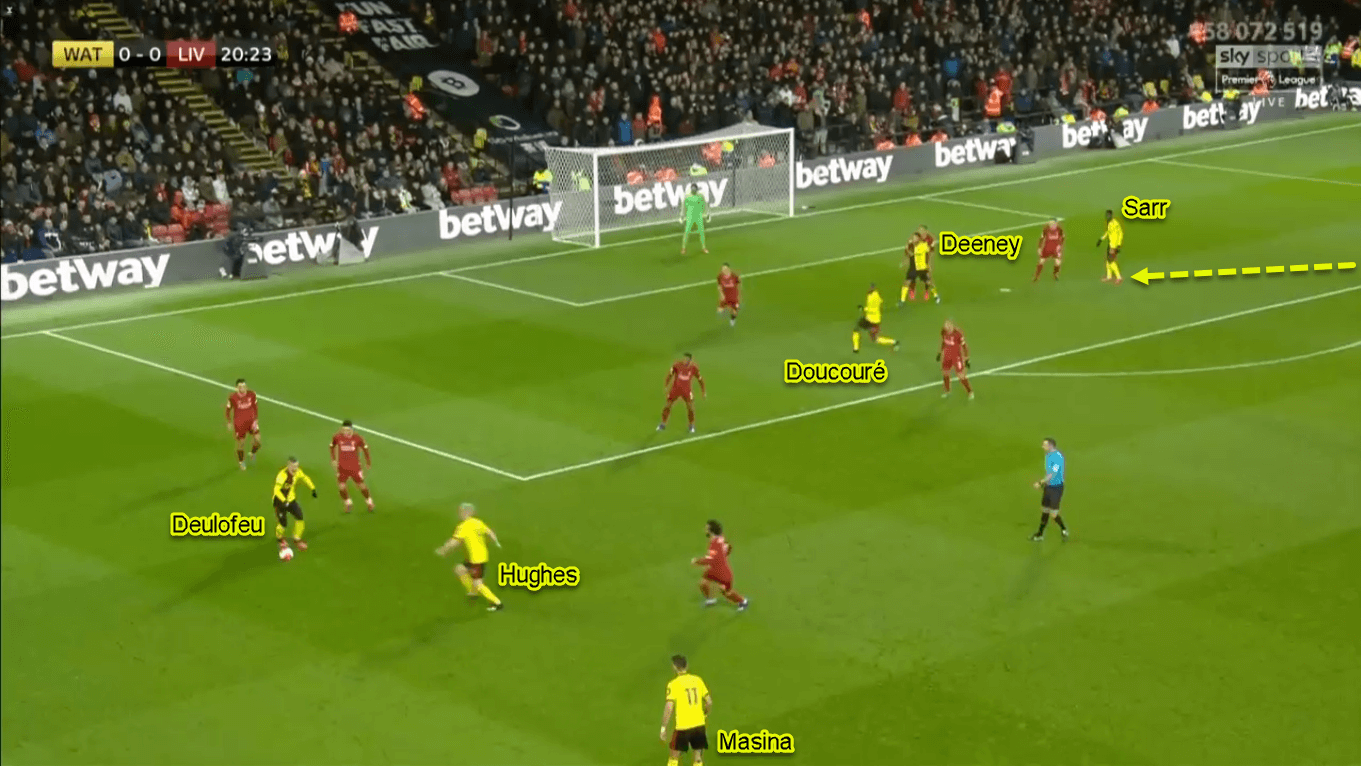
Different from Deeney and Doucouré, Ismaïla Sarr would offer himself by arriving at the far post.
By doing so, he would come from the opponent’s left-back blind spot, making his run more undetectable.
Not only that, but he would also try to attack the channel between the left-back and the centre-back.
Sometimes, Ismaïla Sarr would even finish his run at the goalmouth.
Such aggressive runs would often confuse the defenders on how to close Watford’s attackers inside the box.
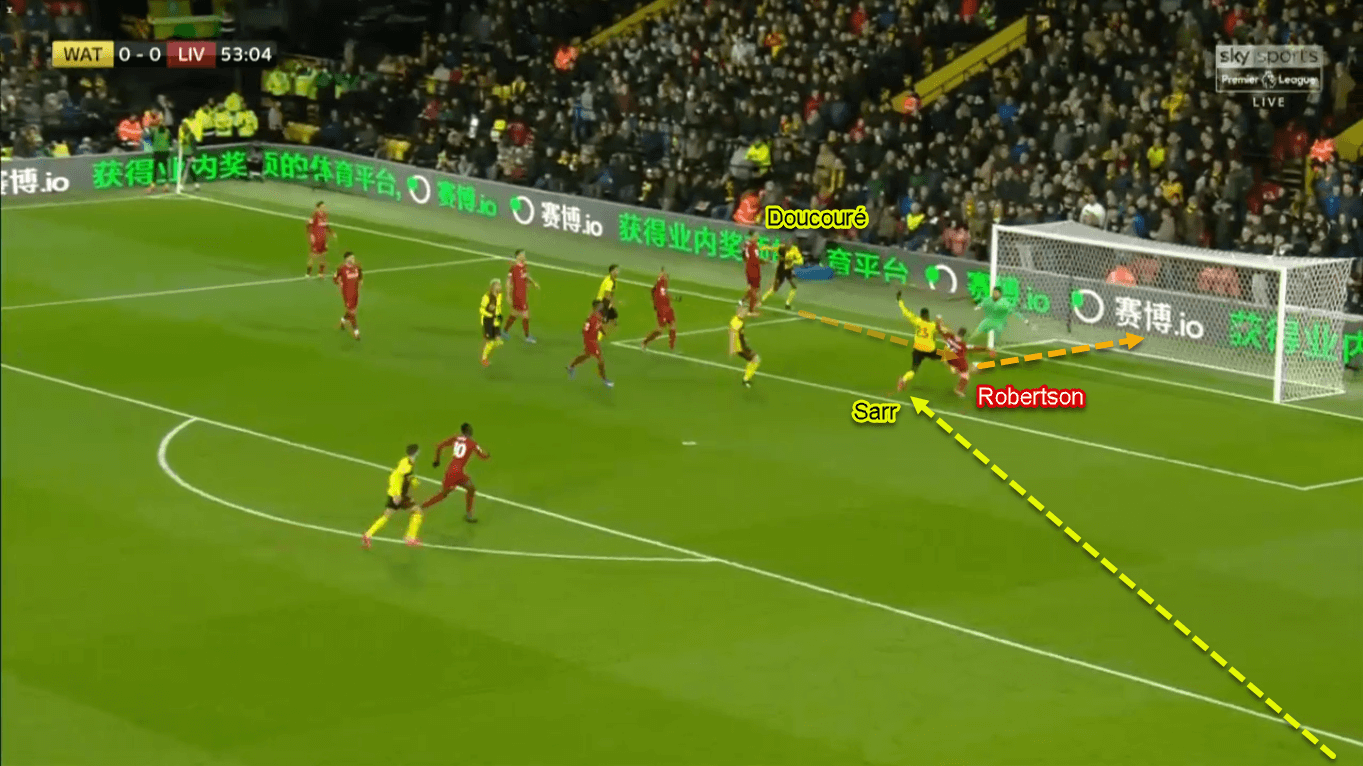
Ismaïla Sarr’s Attacking Patterns
Despite being positioned wide most of the time, Pearson also likes to tuck Ismaïla Sarr inside in Watford’s direct approach.
When engaging in aerial duels, Deeney would drop in between the lines to receive the ball.
In the process, his movement would trigger the nearest opponent’s centre-back to follow him.
Then, the striker would try to head the ball in behind for one of his teammates to the gap just vacated by the defender.
Another variation of Ismaïla Sarr’s Attacking Patterns is to pass the ball to his nearest teammate, regardless of their current positions.
When tucked inside, Ismaïla Sarr’s role is to receive the lay-off from Deeney.
Ismaïla Sarr would come close and try to attack the channels.
Not only that, but he could also attack the gap left by the opponents’ centre-back, who stepped up to follow Deeney.
Ismaïla Sarr’s pace and Deeney’s aerial ability are equally important in helping Watford get the ball inside the box.
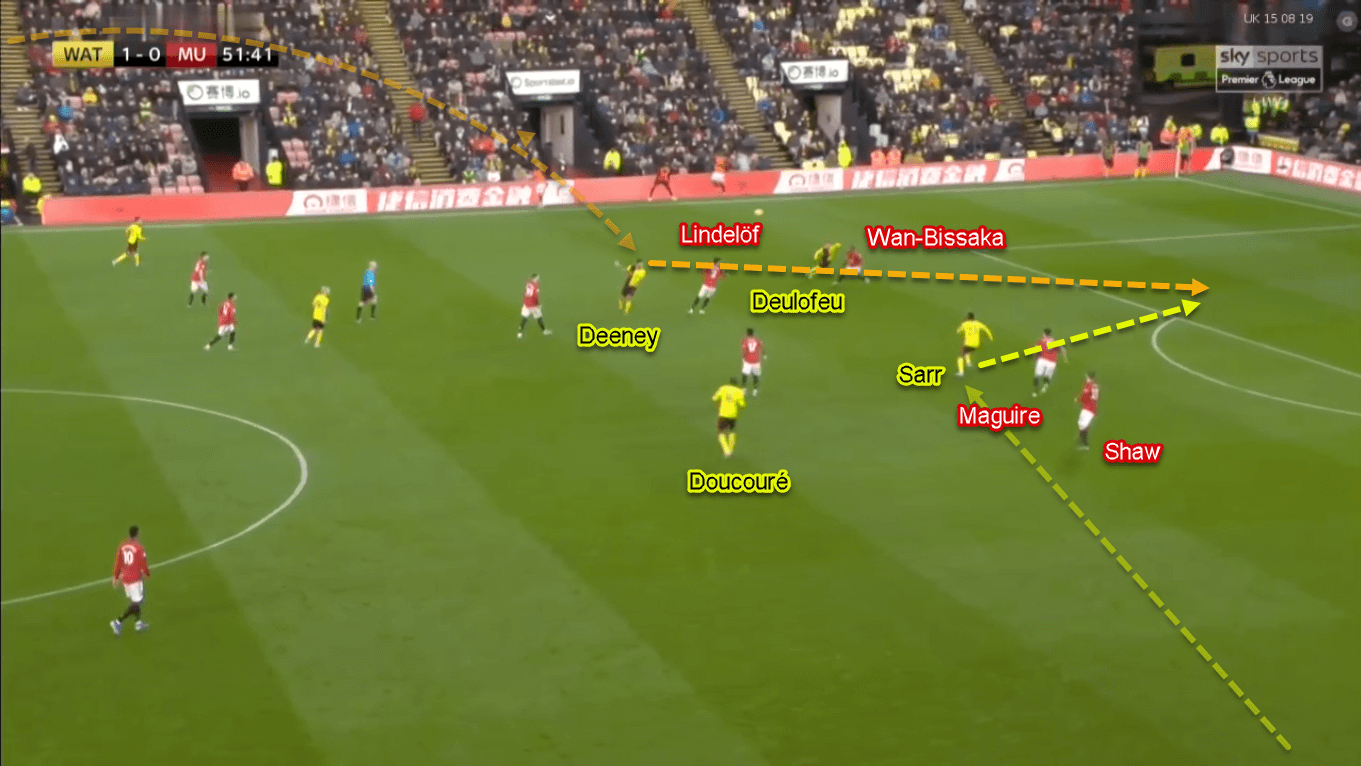
Another reason why Ismaïla Sarr is useful when tucked inside in such situations is his presence.
By being close to his teammates, Ismaïla Sarr could combine with them and try to continue the attack with shorter passes.
It doesn’t stop there.
Ismaïla Sarr could also join the immediate press if the opponents win the aerial duel, thus helping his team regain the ball.
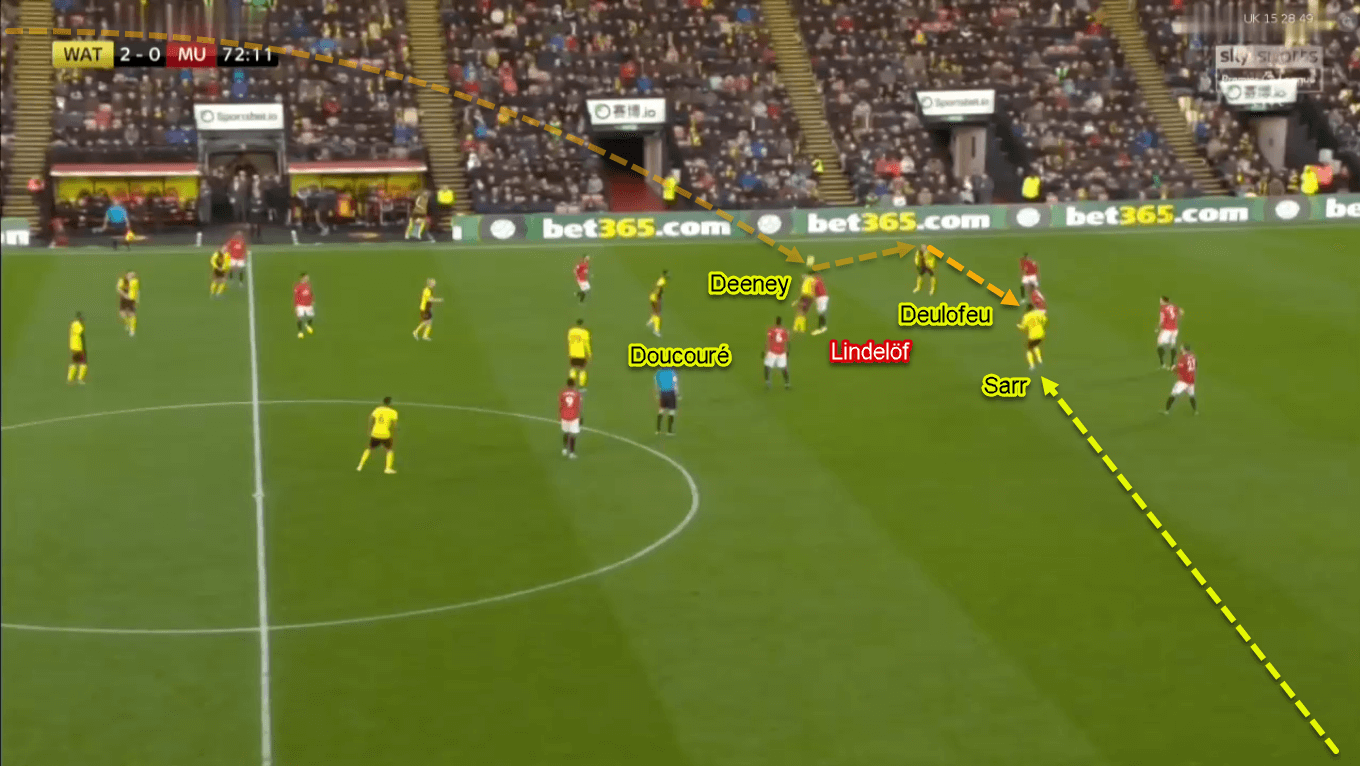
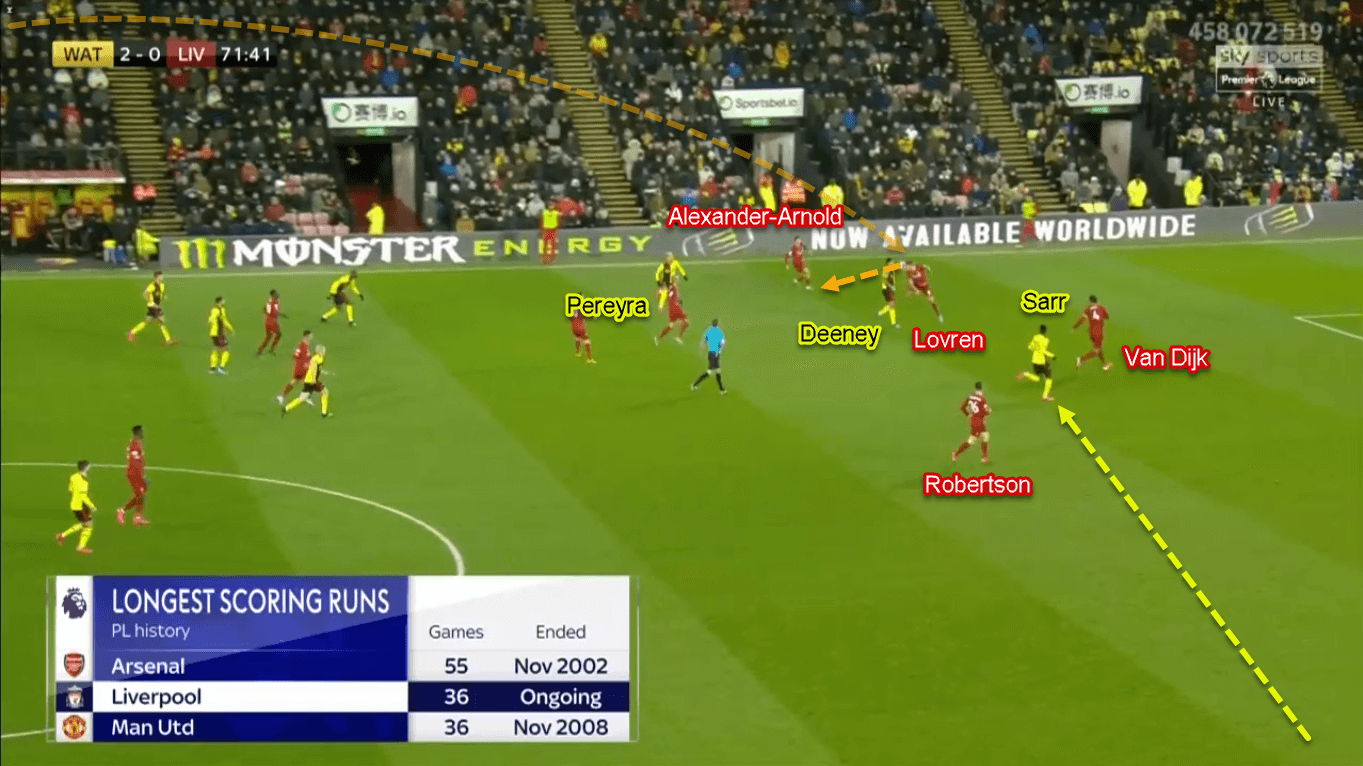
Ismaïla Sarr’s Pace
As mentioned previously in this analysis, playing centrally is not an oddity for Ismaïla Sarr.
Ismaïla Sarr would come to the central part of the pitch whenever Deeney dropped from his position.
The Senegalese then would try to make runs in behind when moving central.
In the process, he would start his run in the channels between the opponents’ defenders.
The objective is to confuse the defenders on who to close him down.
Not only that, Sarr’s exquisite pace most likely allows him to win a footrace against relatively slower centre-backs.
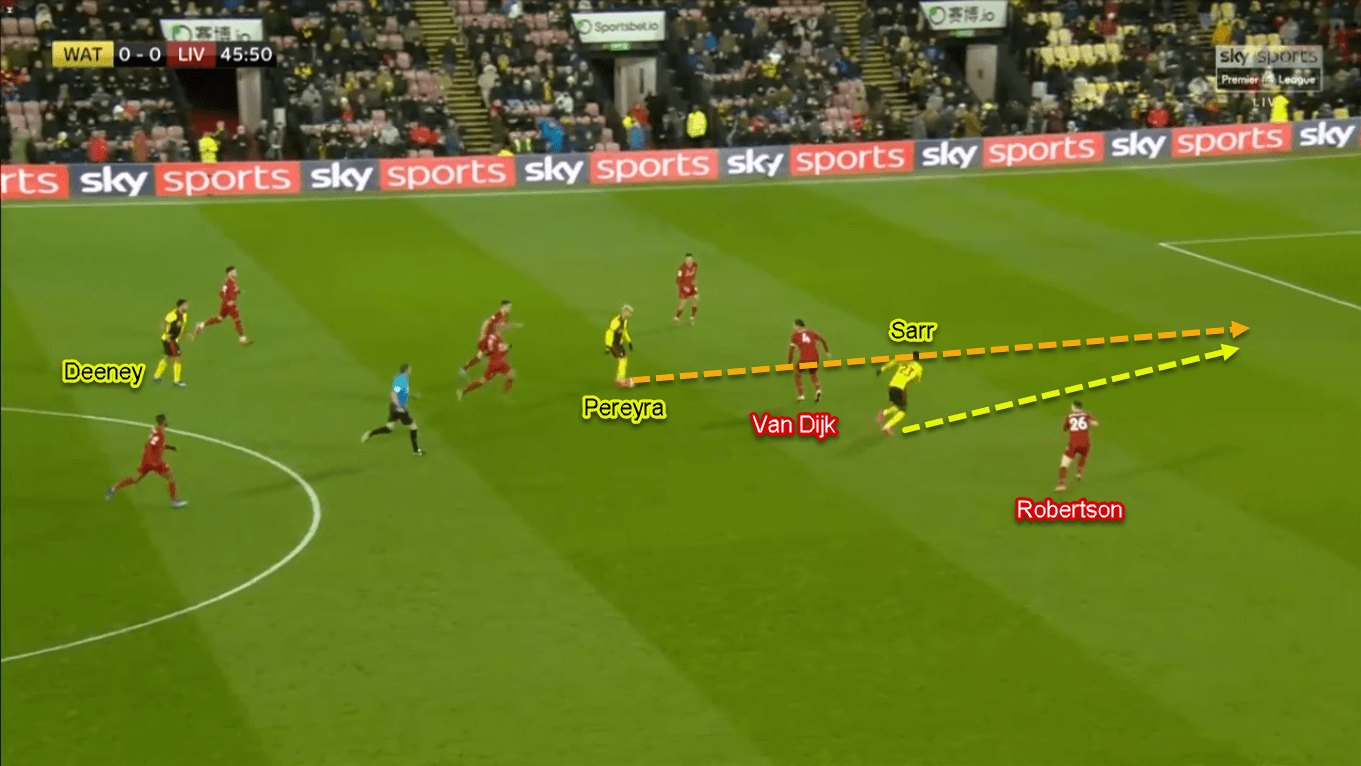
Ismaïla Sarr’s pace is also helpful when he’s positioned in his natural position, on the flank.
In one-versus-one duels, Ismaïla Sarr would try to use this particular ability to get past the defender.
In the process mainly he would try to knock the ball forward and outsprint his marker.
Sometimes, the defender would try to get in Ismaïla Sarr’s way and force him into a more physical duel.
However, it’s not enough to stop Sarr.
The right-winger’s bigger build would most likely allow him to outmuscle the defender and attack the space quickly.
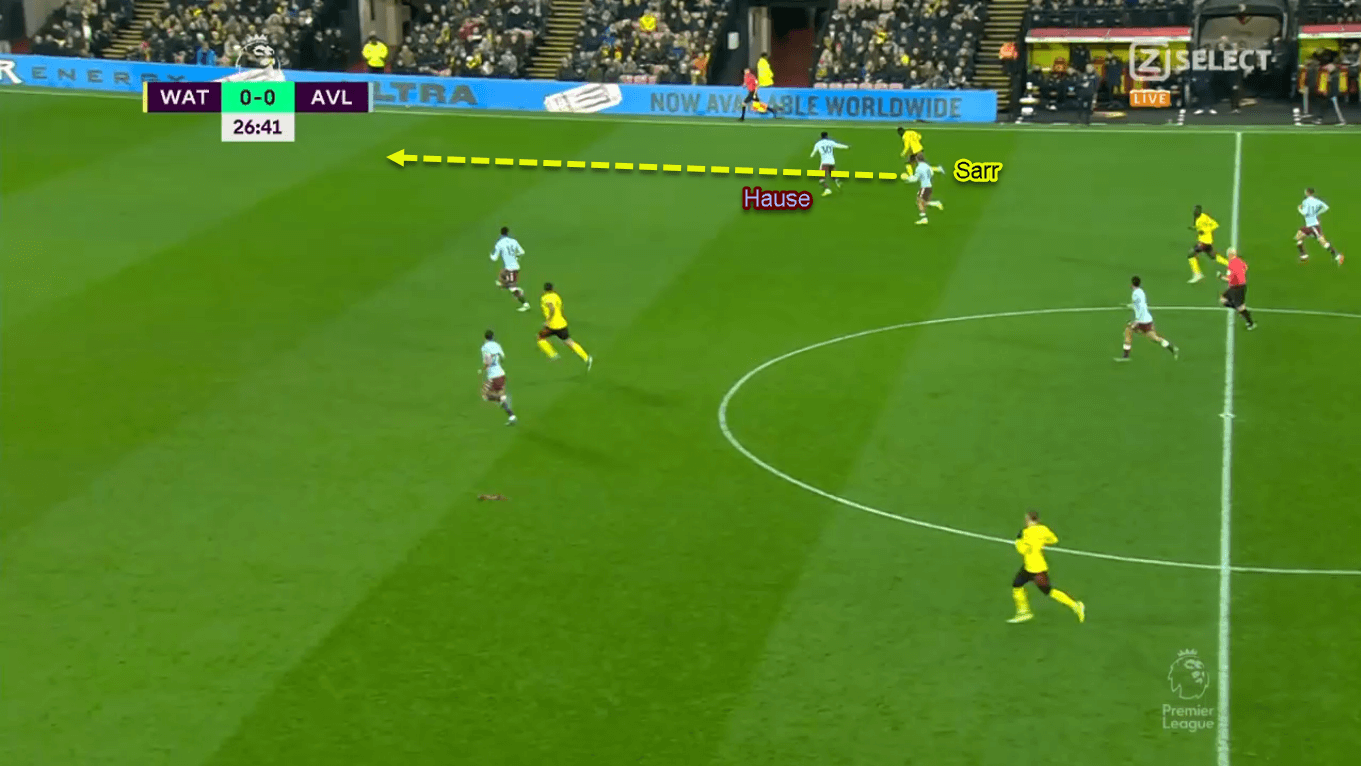
Ismaïla Sarr’s pace is also a good weapon for Watford in transition.
Ismaïla Sarr doesn’t only have good acceleration, but he has unmatched speed and endurance.
These traits enable him to sprint for 50 or 60 metres consistently, making him a dangerous threat in Watford’s counter-attacks.
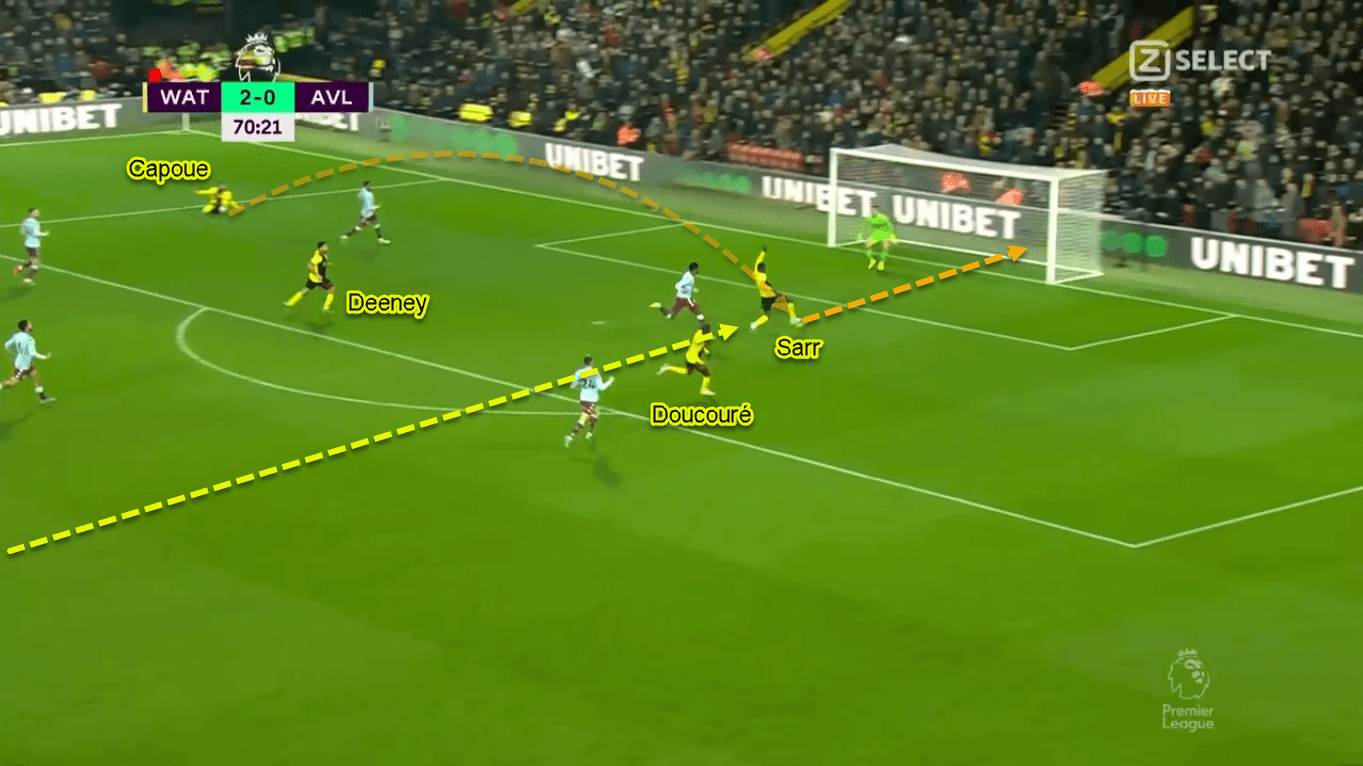
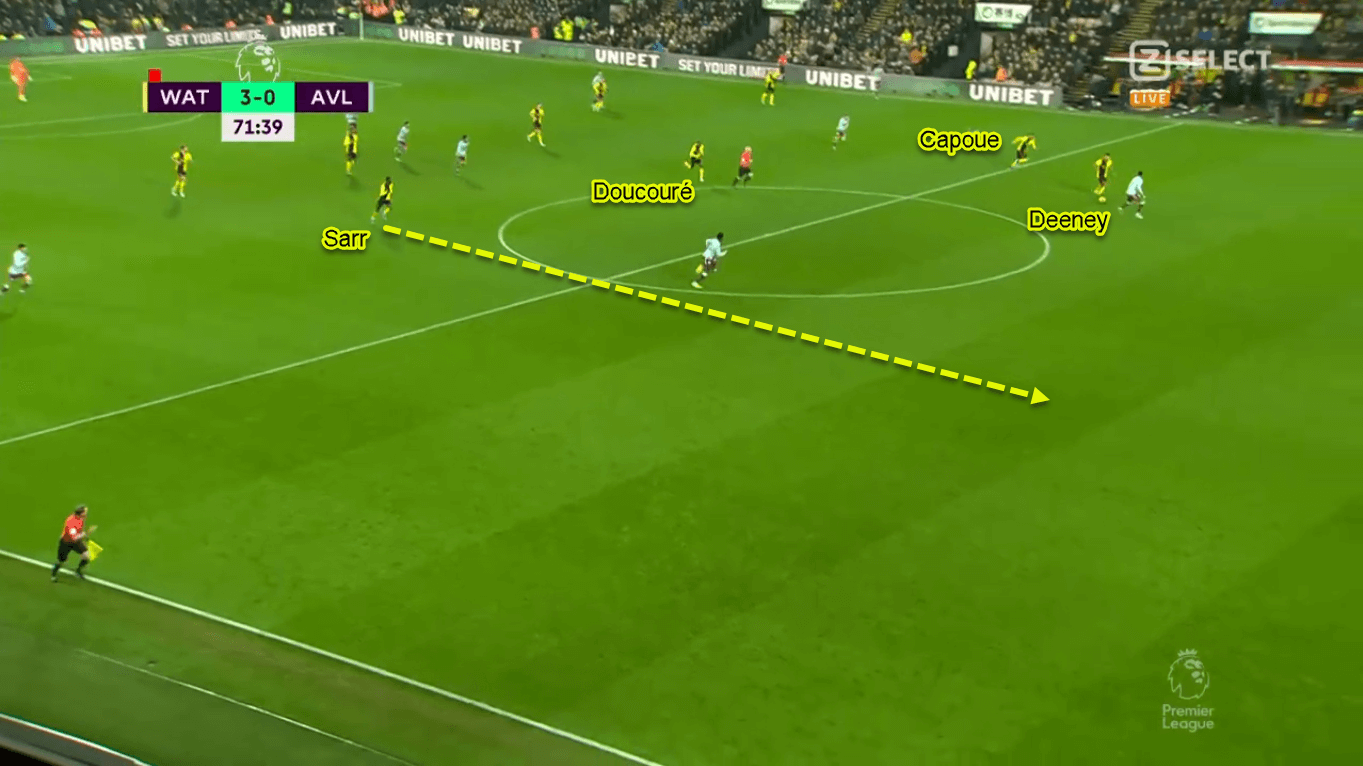
Ismaïla Sarr Defensive Position
Nigel Pearson’s tactics prefer to set his team up in a mid-block 4–4–2 when they don’t have the ball.
However, the shape could also shift temporarily to 4–5–1 if Doucouré retreats to the midfield line.
Furthermore, they could also morph into a more defensive shape, which is a 6–3–1 formation.
One thing that stays in all these shapes is the defensive compactness, both vertically and horizontally.
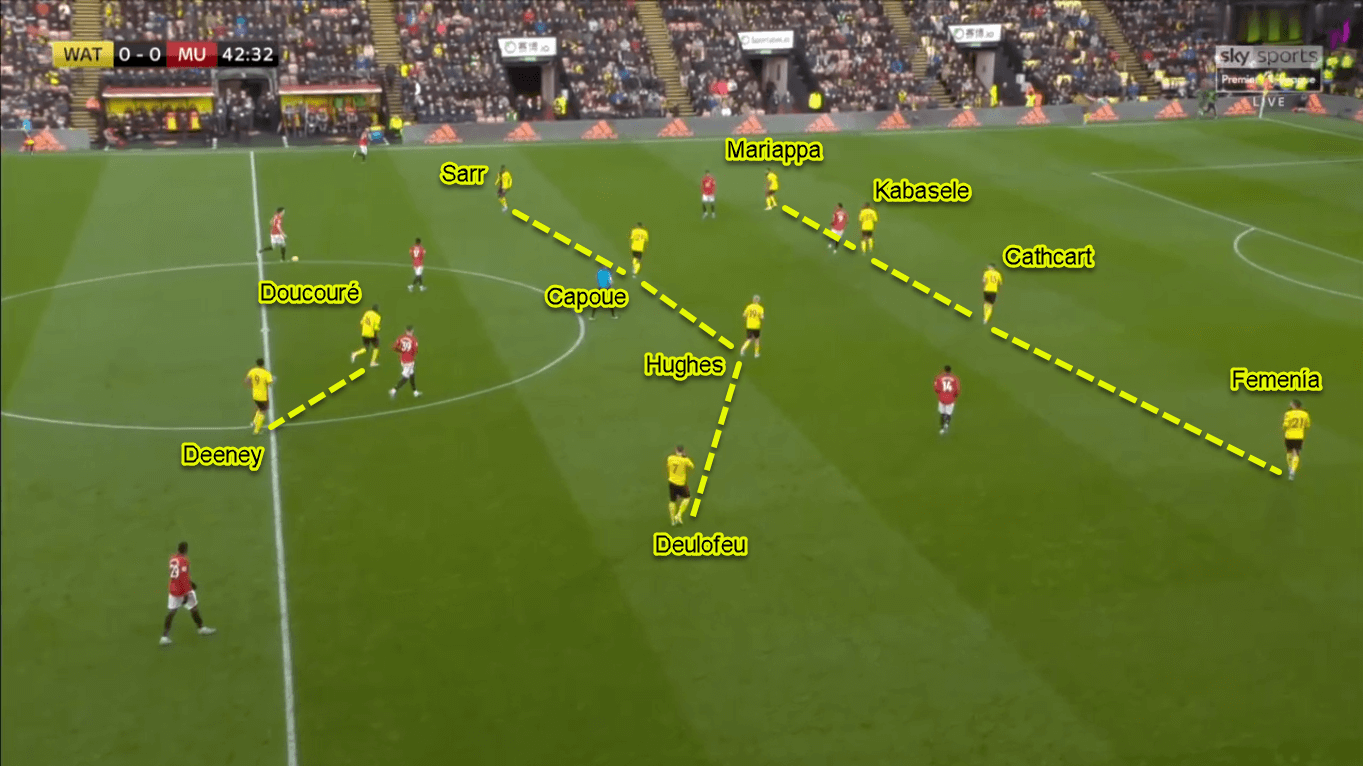
Ismaïla Sarr is tasked with protecting the flank in either the 4–4–2 formation, the 4–5–1 formation, or the 6–3–1 formation.
In the process, Nigel Pearson would allow Ismaïla Sarr to drift wider from his defensive position.
This means that sometimes he could be found closer to the opponent’s wide player(s) rather than his nearest midfielder.
The objective is to prevent the wide player(s) from receiving the ball and let Watford’s backline solely focus on defending the central lanes.
Even if the opponent can switch the ball to Ismaïla Sarr’s defensive position, the Senegalese will be near enough to close his man down, limiting his time and space with the ball.
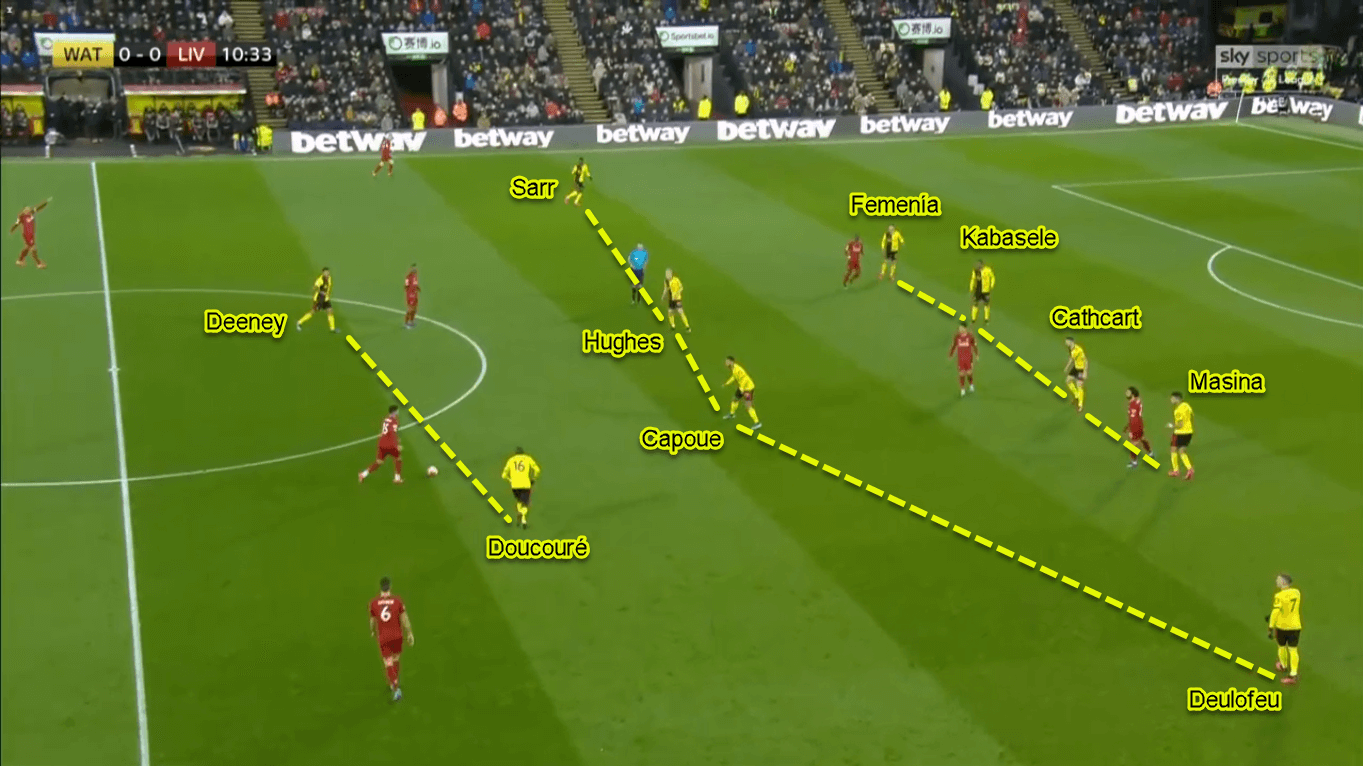
Ismaïla Sarr could also defend a bit more aggressively in the mid-block system.
To do so, he would step up from the midfield line and close down the opponents’ left-back.
By doing that, Ismaïla Sarr would prevent the on-ball centre-back from playing the ball wide.
Even better, this could also force the opponent to play the ball long.
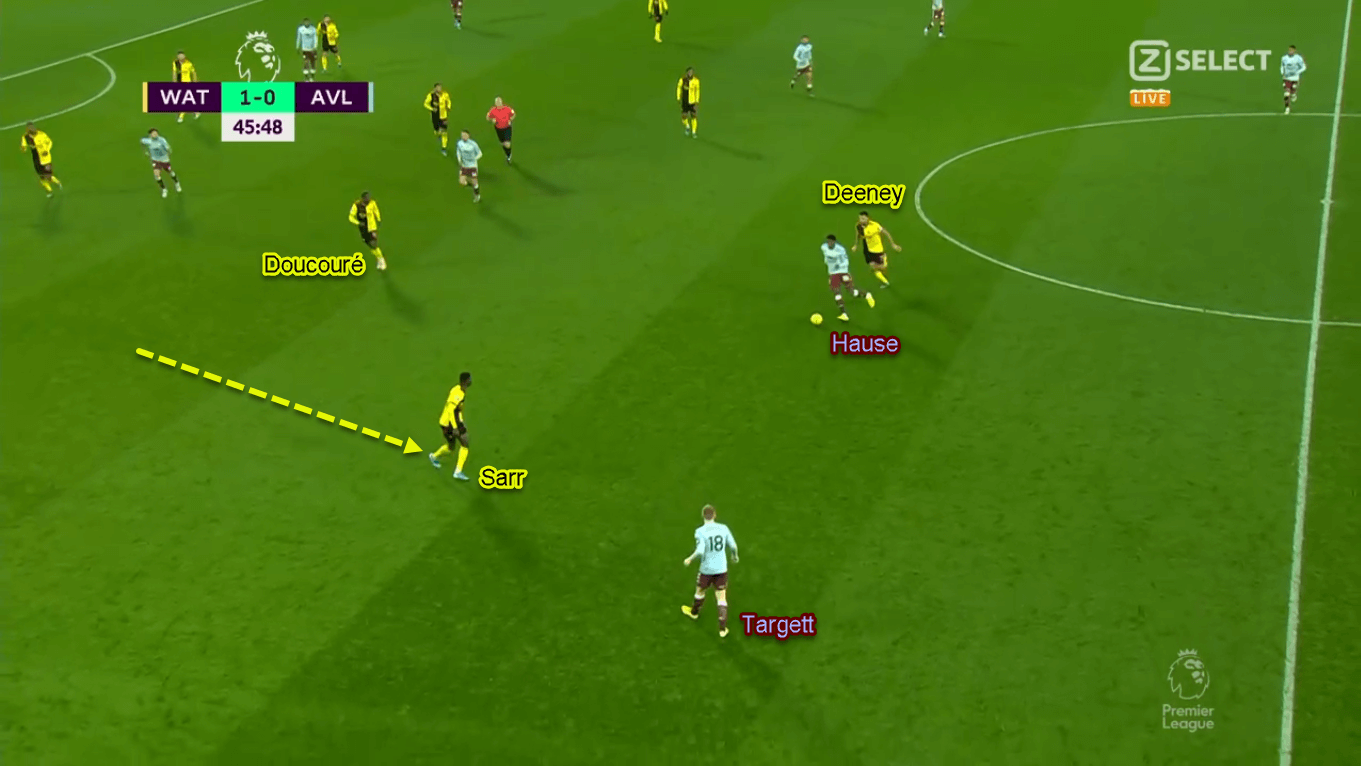
Ismaïla Sarr Style Of Play Weaknesses
As mentioned previously, Ismaïla Sarr is often tasked to provide crosses in the final third.
Unfortunately, he’s not a decent crosser by any means.
If we look at the stats, Ismaïla Sarr only averages 0.8 successful crosses per 90 minutes in the Premier League.
Yet, his attempts soar high at 4.1 crosses per 90 league minutes.
It means Ismaïla Sarr has only a 19.51% success rate when delivering the ball from the vast area.
Another issue in Ismaïla Sarr’s style of play is his lack of quality in one-versus-one duels.
Quite often, Ismaïla Sarr´s style of play relies too much on his physicality to burst into the final third, which makes him somewhat predictable.
On some occasions, the Senegalese would even play a backward pass instead of trying to drive past the defender(s) in front of him.
It’s safe to say that Ismaïla Sarr doesn’t have the trickery as well as bravery to excel in one-versus-one duels.
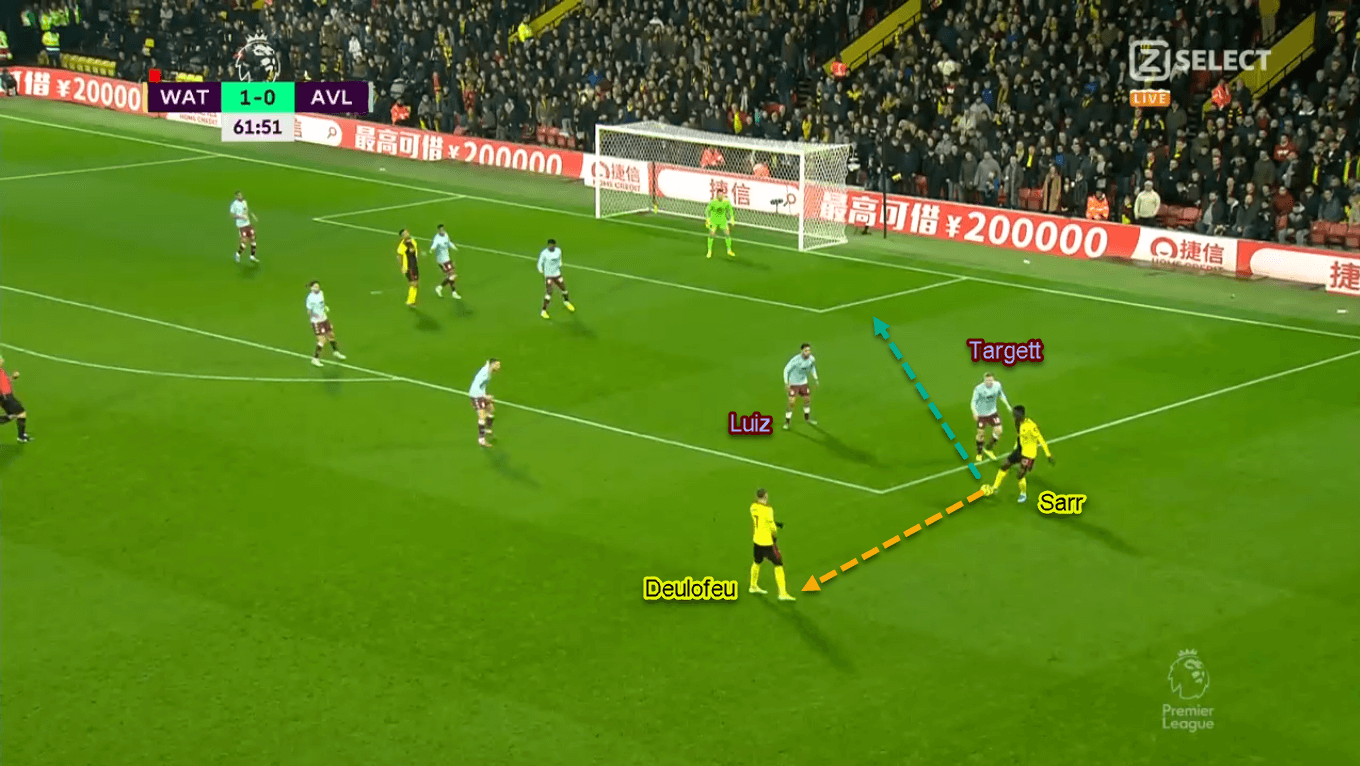
Defensively, Ismaïla Sarr has a big problem to work on.
His main issue is his lack of defensive awareness, especially against the league’s offensive full-backs.
Ismaïla Sarr would focus on the ball too much and let the opponent’ left back attack the space behind him.
Even worse, the left-back would start in Ismaïla Sarr’s eyesight rather than from his blind spot, further underlining his lack of awareness.
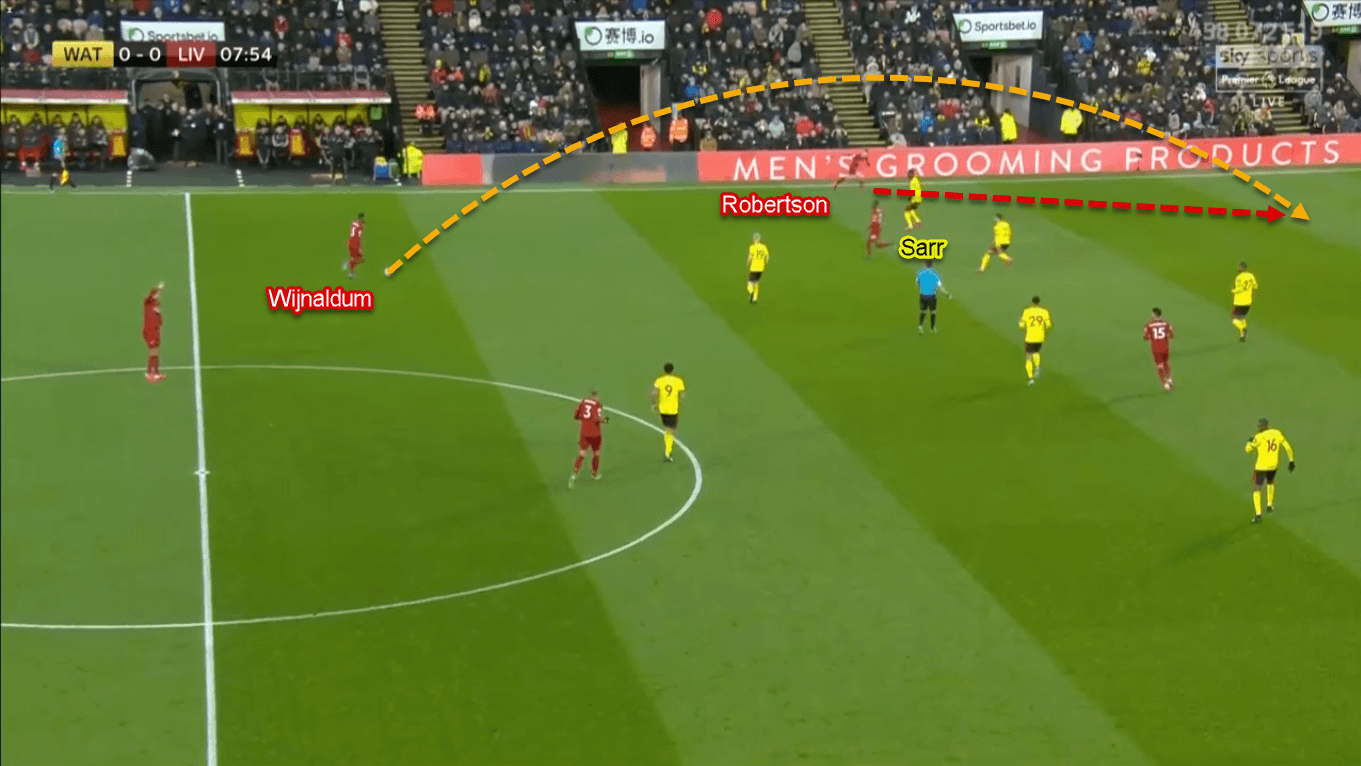
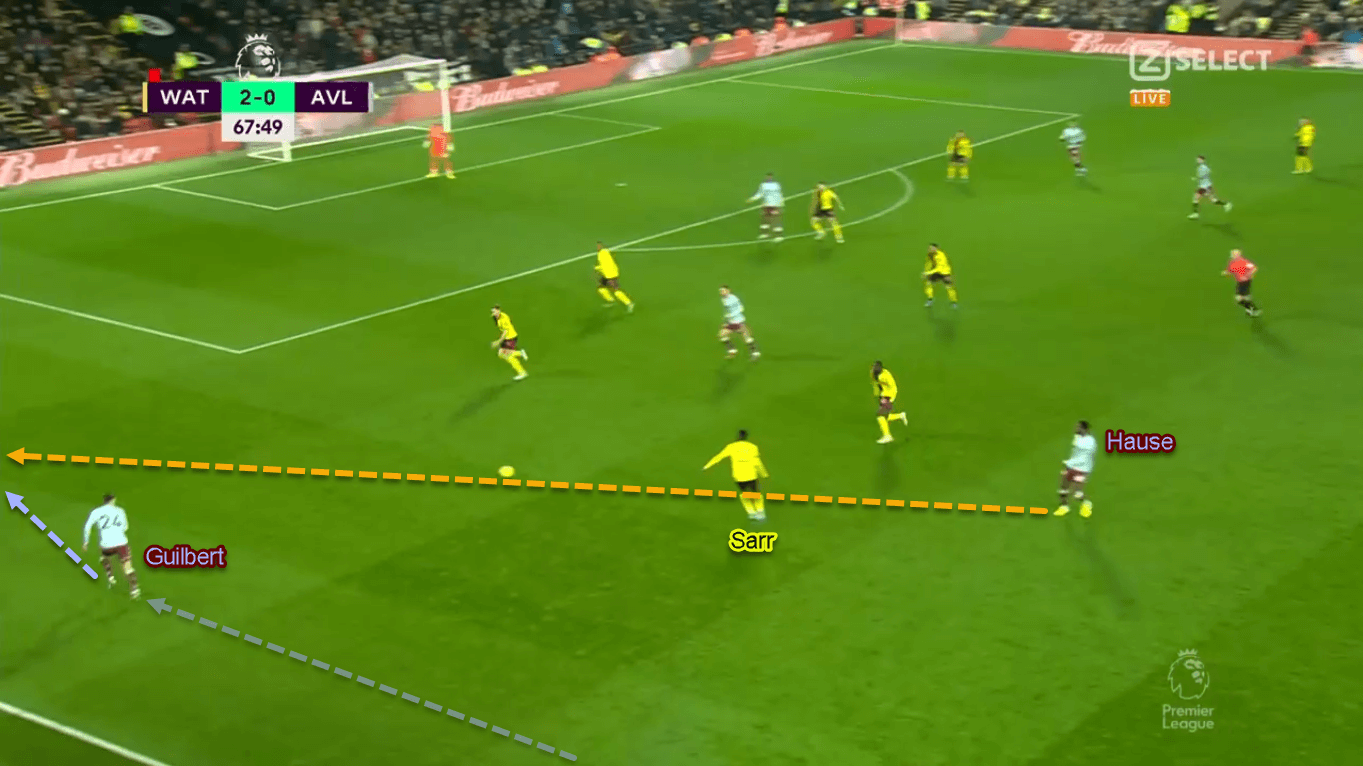
Conclusion
Despite still being a 22-year-old, Ismaïla Sarr has proven his quality in big games.
This season alone he has scored multiple goals against Liverpool and Manchester United.
Tactic-wise, the Senegalese is already an essential figure for Watford.
His physicality and explosiveness suit perfectly to the Hornets’ brand of football.
However, Ismaïla Sarr still needs to add a lot to his game.
As a right-winger, he needs to add some trickery and unpredictability to make him a more dangerous threat in the final third.
Ismaïla Sarr also needs to polish his defensive ability to add more resilience to his team.
Those are the things he needs to do if he wants to secure a big-money move in the future.





Comments